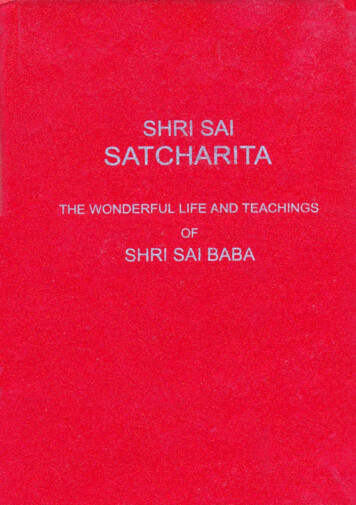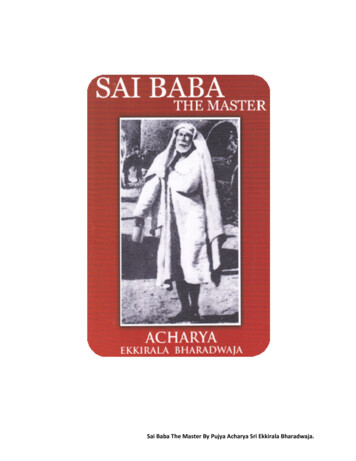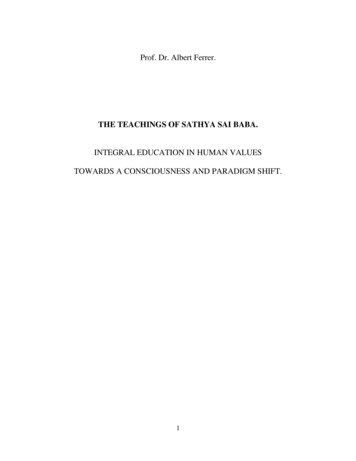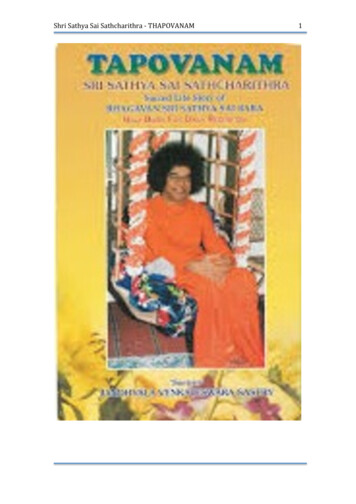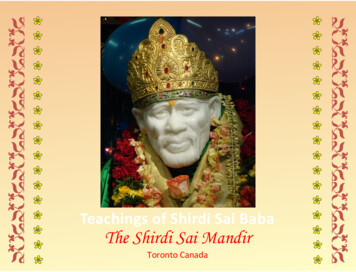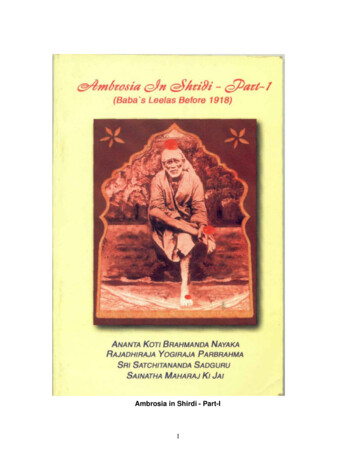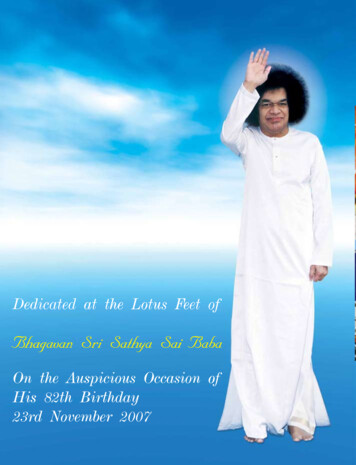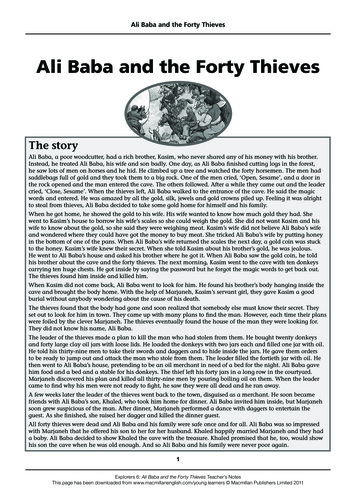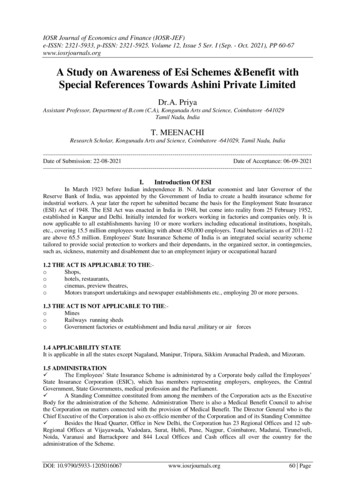
Transcription
MEHER BABA THE AWAKENERSecond Edition (1993)ByCharles HaynesAn Avatar Meher Baba Trust eBookJune 2011Copyright 1989 by Charles HaynesSource and short publication history: This eBook reproduces the secondedition (1993) of Meher Baba the Awakener published by The AvatarFoundation, Inc (North Myrtle Beach, South Carolina).
eBooksat the Avatar Meher Baba Trust Web SiteThe Avatar Meher Baba Trust’s eBooks aspire to be textually exact though non-facsimilereproductions of published books, journals and articles. With the consent of the copyrightholders, these online editions are being made available through the Avatar Meher BabaTrust’s web site, for the research needs of Meher Baba’s lovers and the general publicaround the world.Again, the eBooks reproduce the text, though not the exact visual likeness, of the originalpublications. They have been created through a process of scanning the original pages,running these scans through optical character recognition (OCR) software, reflowing thenew text, and proofreading it. Except in rare cases where we specify otherwise, the textsthat you will find here correspond, page for page, with those of the original publications:in other words, page citations reliably correspond to those of the source books. But inother respects—such as lineation and font—the page designs differ. Our purpose is toprovide digital texts that are more readily downloadable and searchable than photofacsimile images of the originals would have been. Moreover, they are often much morereadable, especially in the case of older books, whose discoloration and deterioratedcondition often makes them partly illegible. Since all this work of scanning andreflowing and proofreading has been accomplished by a team of volunteers, it is alwayspossible that errors have crept into these online editions. If you find any of these, pleaselet us know, by emailing us at frank@ambppct.org.The aim of the Trust’s online library is to reproduce the original texts faithfully. Incertain cases, however—and this applies especially to some of the older books that werenever republished in updated versions—we have corrected certain small errors of atypographic order. When this has been done, all of these corrections are listed in the“Register of Editorial Alterations” that appears at the end of the digital book. If you wantthe original text in its exact original form, warts and all, you can reconstruct this with theaid of the “register.”The Trust’s Online Library remains very much a work in progress. With your help andinput, it will increase in scope and improve in elegance and accuracy as the years go by.In the meantime, we hope it will serve the needs of those seeking to deepen and broadentheir own familiarity with Avatar Meher Baba’s life and message and to disseminate thisgood news throughout the world.
MEHER BABA,THE AWAKENERCharles Haynes
AVATAR FOUNDATION, INC.
Meher Baba, The AwakenerCopyright 1989 Charles HaynesSecond Edition, 1993No part of this book may be reproduced in any form withoutpermission in writing from the author.All of Meher Baba's quotes Copyright Avatar Meher BabaPerpetual PublicCharitable Trust, Ahmednagar, India, except quotes fromGod Speaks, Life at its Best and Beams from Meher Baba on theSpiritualPanorama Copyright Sufism Reoriented,Walnut Creek, California.Other persons quoted from Love Alone Prevails, The God-Manand Treasures fromthe Meher Baba Journals Copyright Meher Spiritual Center.Other persons quoted from The Wayfarers and Silent WordCopyright Avatar Meher Baba Perpetual Public CharitableTrust.Other persons quoted from 82 Family LettersCopyright Universal Spiritual League in America.Other persons quoted from The Glow Copyright NaosherwanAnzar.All quotes from While the World SleptCopyright Bhau Kalchuri, Ahmednagar, India.All quotes from Much Silence Copyright Meher Baba SpiritualLeague, Ltd.All photographs of Meher Baba Copyright Lawrence Reiter,Myrtle Beach, S.C.except for photograph at Narbada River, Jabalpur, (page 110)Copyright Jayne Barry Haynes, Myrtle Beach, S.C.All quotes and photographs used by permission.Printed in the United States of America.Cover Design: Keith Sheridan Associates, Inc.ISBN 0-9624472-1-8Published byTHE AVATAR FOUNDATION, INC.P.O. Box 1367 N. Myrtle Beach, S.C. 29598-1367
AcknowledgementsI wish to thank Meher Baba's men and women mandali forthe insight and inspiration that made this book possible. Iam especially grateful to Eruch Jessawala for his lovinghelp and encouragement.Since he first proposed this book in 1986, Ken Coleman hasworked tirelessly and selflessly on every aspect of theproject. Jeff Wolverton and David Carter made many valuable suggestions that greatly strengthened the book. Davidalso spent many hours checking the references and proofingthe text. Robert Love helped in many ways, great and small,throughout the project. Marsha Forman graciously assistedin the final stages of production.Though it has been much revised, much of the originalmanuscript was written for my doctoral dissertation atEmory University. I owe much to John Fenton and JackBoozer for their guidance and support during that time andthroughout my academic career.Elizabeth Patterson, a disciple of Meher Baba, firstintroduced me to him more than thirty years ago. Her life ofservice will always stand as a living example of MeherBaba's love in action. This book is dedicated to her.Charles Haynes
Throughout this book, with theexception of the Supplement,Meher Baba's words appearin italics. All of the material inthe Supplement was given byMeher Baba.
ContentsINTRODUCTION .11. THE DIVINE THEMEThe story of consciousness; The Journey ofConsciousness;The Divine Romance; The Avatar .52. THE LIFE STORYVeiled Youth; Realized Divinity; Seeker ofGod;The God-Man. .353. THE UNIVERSAL WORK 65Speaking in Silence; Mastery in Servitude;Agents and Masts;Seclusion Work; Universal Suffering; TheNew Humanity4. THE AWAKENING OF THE HEARTThe Path of Love; Knowledge of the Heart;Love, Obedienceand Surrender; Remembrance; The Awakener 85SUPPLEMENTMeher Baba's Universal MessageThe AvatarThe Master's PrayerHow TO Love GodThe Seven RealitiesThe Highest of The High .111 .112 .117 .118 .119 .120FOOTNOTES .128
Meherabad, 1927-28
Introduction"I have come not to teach but to awaken."Meher BabaThe starting point for any discussion of Meher Baba is hisdeclaration that he is the Avatar, the manifestation of Godin human form who comes age after age to awaken all lifeto the love of God. Because it is accompanied by a life ofextraordinary beauty and love, this declaration calls each ofus to open the ears of our hearts and to listen with great care.If we are to listen properly, we should keep in mind thatMeher Baba intended for his real message to be given not inwords, but through an inner experience awakened by love.We are thus challenged to look beyond words andexplanations to the real work of Baba as the Avatar. To thatend, I offer as little interpretation as possible in the pagesthat follow and invite the reader to encounter Meher Babadirectly with nothing in between.The sole aim of this book is to aid the listening of the heartby allowing Meher Baba's awakening of love to speak foritself. The reader should know, however, that the perspective I bring to this effort has been shaped by more thanthirty years of close association with Meher Baba and hisintimate disciples. From the time I first met him in 1958 tothe present day, Baba has been at the center of my life.It may also be helpful to state at the outset Meher Baba'sassertion that God is the only Reality, the true Self of everyfinite self. It follows, then, that the work of the Avatar is tobe understood as the story of God awakening the divineReality within each of us through love.[1]
INTRODUCTIONFor nearly fifty years Meher Baba worked to accomplishthis awakening of love. Vital and active, Baba traveledwidely, met thousands of people, and served, among others,the sick, the poor, and the mentally disturbed. Through it all,he reminded those around him that his activities were onlyto be taken as outer signs of the inner work that the Avatarhad come to do.Baba's awakening of love springs from silence, for he didnot utter a word for the last forty-four years of his life.When he found it necessary to use words, he gaveexplanations and statements indirectly through handgestures and by spelling them out on a board with the lettersof the alphabet painted on it. He kept silence, he said, inorder to break his silence by speaking the Word of Godwithin every heart.A few months before his physical death in 1969, Baba toldhis close disciples that his work was now complete and theresults would unfold in time. Now, some twenty years later,thousands of people have come to love him, accepting himas the Avatar of our age. Their relationship with MeherBaba is direct and personal despite his physical absence.Though Baba stressed that his work of awakening is deeplyintimate and personal, it also has universal ramifications. Heindicated that the divine love he came to release willtransform consciousness, inaugurating an era of oneness. InBaba's words, dictated from his silence:I have come to sow the seed of love in your hearts sothat in spite of all superficial diversity which your life inillusion must experience and endure, the feeling ofOneness through love is brought about amongst allnations, creeds, sects and castes of the world.In this new humanity, Meher Baba promised that the worldwill awaken to the unity of all life in the midst of diversity.It follows, therefore, that Baba did not wish to found aseparate religion or prescribe a new creed, but rather torenew the Truth that is at the core of all faiths:[2]
INTRODUCTION/ am not come to establish any cult, society or organization; nor even to establish a new religion. The religionthat I shall give teaches the Knowledge of the Onebehind the many. The book that I shall make people readis the book of the heart that holds the key to the mysteryof life. I shall bring about a happy blending of the headand the heart. I shall revitalize all religions and cults,and bring them together like beads on one string.The dynamics of Meher Baba's awakening of love are thecentral focus of all that follows. We begin in chapter onewith the story of the cosmos, the divine theme, given byBaba from his silence. Here the reader is provided aframework for understanding the ways of the Avatar,insofar as they can be grasped by the mind. Chapter twotells the life story of Meher Baba in light of his declarationthat he is the Awakener of divine love. The remaining twochapters explore Baba's work of awakening in its twofundamental dimensions: the universal transformation ofconsciousness, and the personal relationship of the loverand the Beloved.One final note: the reader is asked to keep in mind that anawakening of love is, by its very nature, an individualexperience that must come from deep within each person.There are as many approaches to God as there are individualsouls. My only task here is to provide hints and clues so thateach seeker of God may find his or her own way to theTruth, a way that is illuminated not by words but by lovealone. As Meher Baba has said:Love has to spring spontaneously from within; it is in noway amenable to any form of inner or outer force. Loveand coercion can never go together; but while lovecannot be forced upon anyone, it can be awakenedthrough love itself.Charles HaynesFebruary 1989[3]
Nasik, 1936[4]
Chapter 1The Divine ThemeOnce when asked "Have you a scripture, a Bible, a Koran,an inspired book?," Avatar Meher Baba replied: "No, Iawaken. I am an awakener." The true message awaited bythe world, he said, is an inner experience of divine love, notanother explanation given in words:Today the urgent need of mankind is not sects ororganized religions, but Love. Divine love will conquerhate and fear. It will not depend upon otherjustifications, but will justify itself.I have come to awaken in man this divine love. It willrestore to him the unfathomable richness of his owneternal being and will solve all of his problems.1When Meher Baba did give explanations, it was only topoint beyond words to the inner transformation broughtabout through love. As if to underscore the limitations ofwords, he "spoke" from oral silence, reminding us that hisreal "speaking" must be heard by the ears of the heart.Keeping before us this vital distinction between words ofexplanation and the real work of divine love, we explore inthis chapter the divine theme of creation as described byBaba. The understanding gained by this exploration isoffered by Baba only to aid the seeker in stilling the mindand thereby clearing the way for the heart to hear theAvatar's Word of love when he speaks it.[5]
The Story of ConsciousnessFor Meher Baba, the Avatar's work of awakening is alwayspart of the larger story of awakening constantly taking placethroughout the universe. The central theme of the story islove, evolving from very rudimentary beginnings andultimately culminating in universal or divine love. Seen interms of consciousness, the awakening is a movement inUltimate Reality, God, from a state of unconscious divinityto one of conscious divinity. This movement inconsciousness is described by Baba in metaphoricallanguage as a journey through the multifarious experiencesof the illusory universe in which God ultimately awakens toHimself.In telling the story of consciousness Meher Baba "spoke" asone who had absolute knowledge of the workings of theuniverse; he appealed to no scripture or authority otherthan his own experience of God. He did not, however,consider his explanations to be without precedent; he sawhis words as contemporary revelations of ancient truths.Baba's story of how Reality comes to know Itself throughthe experience of the phenomenal universe may be likenedto a "map of consciousness" that serves to guide one'sthinking about the journey of consciousness. Baba'sdescription of the spiritual journey and the ultimate goal ofunion with God, is like a map to a traveler. No matterhow much one memorizes the map, learning the routes andplaces along the way, it is no substitute for the actualjourney. To believe in God and the path to Him cannot inany way replace the actual experiences leading toRealization. Unlike many existing explanations of thespiritual journey, Baba places special emphasis on the"consciousness" acquired during the course of the journeyto Infinite Consciousness.How does God come to know His own Self? We begin theoverview of the journey by noting that, according to MeherBaba, there is only one Reality, God, and all living thingsare ultimately expressions of the Absolute Oneness that isGod. We can, however, speak of differencesof consciousness within[6]
God, represented by all forms in creation and originating inwhat Baba termed the "Beyond the Beyond" state of God.There is only one Reality, which may be called theOversoul (Paramatma), that is only apparently differentiatedin creation. The development of consciousness that resultsfrom this differentiation is what Baba described as thepurpose of the universe:The sole purpose of creation is for the soul to enjoy theinfinite state of the Oversoul consciously. Although thesoul eternally exists in and with the Oversoul in aninviolable unity, it cannot be conscious of thisunity independently of creation, which is within thelimitations of time. It must therefore evolveconsciousness before it can realize its true status andnature as being identical with the infinite Oversoul,which is one without a second. 2According to Baba, what we term the individualized soul(atma) is in relationship with and at the same time identicalto the Oversoul. To elucidate this paradox Baba employedthe ocean-drop metaphor:Before the world of forms and duality came intoexistence, there was nothing but God, i.e., an indivisibleand boundless ocean of Power, Knowledge and Bliss.But this ocean was unconscious of itself. Picture toyourself this ocean as absolutely still and calm,unconscious of its Power, Knowledge and Bliss andunconscious that it is the ocean. The billions of dropswhich are in the ocean do not have any consciousness;they do not know that they are drops nor that they are inthe ocean nor that they are a part of the ocean. 3Here we are asked to imagine God as the infinite ocean, theall-inclusive, all-absorbing Reality. And, in the countlessdrops within the ocean, we can imagine ourselves latentlypresent in the beautiful, mysterious ocean, unconscious ofour true nature.Latent within the Original Ocean, or God, beforeconsciousness sprang into existence, was the Divine Lahar,[7]
defined by Baba as the "so-called whim" of God to knowHimself. At some "point" beyond reason and descriptionbefore the existence of time and space—the Lahar of Godexpressed itself:The unitarian Beyond is an indivisible and indescribableinfinity. It seeks to know itself. It is of no use to ask whyit does so. To attempt to give a reason for this is to beinvolved in further questions and thus to startan unending chain of reasons for reasons, reasons forthese reasons and so on ad infinitum. The plain truthabout this initial urge to know itself is best called awhim (Lahar). A whim is not a whim if it can beexplained or rationalized. And just as no one mayusefully ask why it arises, so no one may ask when itarises. "When" implies a time series with past, presentand future. All these are absent in the eternal Beyond. Solet us call this initial urge to know a "whim." You maycall this an explanation if you like or you may call it anaffirmation of its inherent inexplicability. 4Baba then has us imagine the beginningless beginning,when the Lahar (urge to know) first emerged from God:A puff of wind then stirred the tranquil uniformity of thisocean, and immense waves, countless drops of water,and innumerable bubbles appeared from out of theuniformity of the limitless, infinite ocean. The puff ofwind that set the ocean into commotion may becompared to the impulse of the infinite, original urge-toknow originating with the infinite, original whim ofGod, surging in God to know Himself through Hisinfinite God State.5This "disturbance" stirs the ocean and every drop within theocean. Note that there are no divisions in the ocean, yet theimage of drops presents the idea of latent individuality:Thus Paramatma [Oversoul] in His infinitelyunconscious state . being urged to know Himself,simultaneously bestirs the tranquil poise of everyatma [soul] in[8]
Paramatma [Oversoul] with an urge to know itself.This could only be understood when Paramatma iscompared to an infinite ocean and the atmas to thedrops of that infinite ocean. But it must also be wellnoted that every drop of the ocean, when in theocean, is ocean itself, until the drops inherit6individuality through bubble formationsover thesurface of the ocean.The ocean-drop metaphor is given to help us grasp themeaning of individual existence. Individual drops may beviewed as separate centers of consciousness, eachundertaking a "journey" back to the ocean. But drops in theocean are not unique in themselves; as drops they areidentical to one another, and they are identical to the oceanitself. The ultimate goal is not individuality, but rather theindividual experience of conscious oneness with the ocean.Bestowal of individuality by the Lahar of God creates theillusion of separation:When this urge makes the still water move, thereimmediately spring up numerous bubbles or formsaround the drops; and it is these bubbles whichgive individuality to the drops. The bubbles do not andcannot . separate the drop from the ocean; they merelygive to these drops a feeling of separateness or limitedindividuality.7The drop-bubble experiences itself to be separate from theocean and asserts its separative existence as a drop. Ratherthan identifying itself as the Ocean, the soul (drop-soul)begins its journey in consciousness by identifying withcountless forms, beginning with the stone form, evolvingthrough plant and animal forms, and ultimately attaining thehuman form after eons and eons of time. These formscorrespond to the many levels of ascending consciousness(layers of bubbles). While such identification allows for anever-evolving development of consciousness, it also createsa false notion of separateness, the ego, which eventuallymust be overcome before there is the complete liberation ofthe soul, for in the conscious experience of God there can beno separateness.[9]
Drawing further on the language of the metaphor, Babatermed the false identification of the drop-soul with itsmany forms the "bubble of ignorance." Ignorance, in thisinstance, is not merely a state of unknowing; it is anexperience of separative existence which is inextricablylinked with ever-expanding consciousness. Oncegained, consciousness continues to identify itself with theforms acquired during its development. The drop, so tospeak, believes itself to be a bubble when in reality it is theocean itself. In this sense, ignorance may be said to bea turning away of God from Himself for the sake ofconsciousness. And, as the image of a bubble on the surfaceof the ocean suggests, the separation is only apparent andtemporary.The drop-soul remains in ignorance as long as it identifieswith its separative existence as a bubble ("I am stone," "Iam animal," "I am human," etc.). Only the ocean is real,lasting and unchanging. When the bubble bursts for the lasttime and the drop returns to the ocean, real "knowledge" isgained:A drop in an ocean is not separate from the ocean. It is abubble over the drop that gives it an appearance ofseparateness, but when the bubble bursts the drop is not,and the indivisible ocean is. When the bubble ofignorance bursts the self realizes its oneness with theindivisible Self.8In the beginningless beginning the drop in the ocean did notknow itself to be either a drop or the ocean. Throughapparent separation as a bubble the drop experiences itselfto be an individual drop until consciousness is fully attainedand redirected toward its reality as the Ocean itself. Thenthe drop falls back into the ocean, no longer experiencingseparative existence ("I am a drop"), but knowing itselfto be one with the ocean ("I am the ocean"). Just as theindividual drop in the ocean experiences itself to be onewith the ocean, so the individual soul knows itself to be onewith the Oversoul.The ocean-drop metaphor was used by Baba to direct ourattention to his description of God-realization as a return tothe Source of our being. It is, however, a return witha difference:[ 10 ]
If salvation means reverting to the original state of theOcean, then all the trammels and travails of the bubble(individual soul) through the long and laborious stagesof evolution have been to no purpose.9The difference is that consciousness is gained, and thisachievement gives meaning and value to the entire divinedrama of Self-discovery. Thus the Lahar set in motion whatwe call creation, which is best understood as God's lila, thedivine play of Self-discovery. God initially allows Himselfto be limited in order to ultimately experience Himself asunlimited.The ocean-drop metaphor as used by Baba offers a veryspecific picture of the relationship between God and theindividual. God is One, and our notions of individuality arefalse as long as they are rooted in our separative existence.Nevertheless, the final realization of God, the "I am God"state, is an individual experience which puts an end to allprevious states of false identity:Thus, when each individual drop sheds its falseawareness of being other than the Ocean, it proclaimsitself as the Infinite Indivisible Ocean. At the instant itsfalseness, its very own falseness is removed, the dropasserts its Infinite Individuality.10The Original Question ("Who am I"), according to Baba,continually seeks the "Original Answer" ("I am God"), butin the process the Original Question receives innumerablefalse answers provided by the illusory forms of evolution (Iam stone, I am man, etc.) before the Original Answer isexperienced. Baba said:Due to His own infinite whim God acquires theconsciousness of His reality and realizes His infinite,eternal unlimited Self to experience His unbounded,unlimited and infinite trio-nature [infinite knowledge,power, bliss: sat-chit-ananda].11[ 11 ]
The Journey of ConsciousnessThe process of acquiring consciousness was likened byBaba to a journey which every soul (atma) must undergoand complete. The journey is said to have three basic stages:evolution, reincarnation and involution.Evolution, as explained by Baba, is the first stage of thejourney, the "descent" of the soul from the original soundsleep state of God into creation. In evolution,consciousness gradually evolves through successiveidentification with stone, metal, vegetable, worm, reptile,fish, bird, animal and ultimately human forms. This processparallels in some respects Darwinian theories, though it isa fundamentally different explanation of evolution:evolution in Baba's view is necessitated by the developmentof consciousness. Thus form follows consciousness and not,as in Darwin's theory, the other way around.The full flower of evolution is achieved in the human formwhen full consciousness is attained. Then commences thesecond stage of the journey, reincarnation, during which thesoul lives out the impressions (sanskaras*) gainedin evolution and acquires new impressions by experiencingthe countless varieties of human life. The old and newimpressions, both of which create a veil over consciousness,gradually wear away, revealing an increasinglyclearer experience of God; that is, the soul wearies of theworld and is ready to begin the third phase of the journey,involution, which may be seen as the "ascent" back to God.Let us look at each stage of the journey more closely.In evolution, consciousness expands by associating withincreasingly more complex forms. The impressions gathered in each form push consciousness forward to the nexthigher form:* "Impressions" or "sanskaras" may be defined asaccumulated imprints of experiences acquired by each soulin the journey of consciousness.[ 12 ]
Owing to the arising of the bubble, the drop-soul whichwas completely unconscious is invested withindividuality (or a feeling of separateness) as well aswith very slight consciousness. This consciousness,which has sprung up in the drop-soul, is not of itself norof the ocean; but it is of the bubble or the form, whichin itself is nothing. This imperfect bubble at this stage isrepresented by the form of a stone. After some time, thisbubble or form bursts and there springs up in its placeanother bubble or form. Now, when a bubble bursts, twothings happen: (1) there is an increase in consciousnessand (2) there is a twist or consolidation of impressionsor sanskaras accumulated during the life of the previousbubble.the drop-soul is still conscious only of this newbubble or form and not of itself nor of the ocean.12Form after form arises as consciousness expands and seeksthe next most appropriate form for expression. Theimpressions gathered in the stone form compel theemergence of a higher form, metal, and the impressionsgathered in the metal form compel the emergence of a stillhigher form and so forth.As each individualized soul journeys through evolution itgathers more and more impressions, and these impressionscreate the various forms necessary for the developmentof consciousness. "To view things in their rightperspective," Baba indicated, "we have to see all forms,including human forms, as evolved for the fulfillment of theone eternal divine life." The urge-to-know goes forward asconsciousness moves through the rudimentary stone andmetal forms in which energy is dormant, to the moreadvanced vegetable forms:In the vegetable kingdom, consciousness realizes itselfas half animate and half inanimate. The increasedconsciousness of the vegetable-form asserts its existencein the gross world through an upright or erect stand.The vegetable forms have to take the help of some otherthings such as earth or rock for maintaining an erectposition. They can[ 13 ]
neither stand by themselves nor move voluntarily fromplace to place since they are rooted in one spot.13Not only does the soul experience ever-increasinglycomplex physical impressions, but also impressions havingto do with energy and mind:Emergence of a still more developed form ofconsciousness becomes possible when the Absolute seeksmanifestation through the instinctive life of insects, birdsand animals, which are aware of their bodies andrespective surroundings, which develop a sense of selfprotection, and aim at establishing mastery over theirenvironment. In the higher animals, mind or thoughtappears, but its working is limited by such instincts asthose of self-protection and the care and preservation ofthe young. So even in animals, consciousness has not itsfull development, with the result that it is unable to servethe purpose of the Absolute to attain self-illumination.14These emerging impressions of energy and mind comprisewhat Baba termed the subtle and mental bodies. The subtlebody consists of all impressions having to do with energyand the mental body of all impressions having to do withinstinct, intellect, emotions and desires.The soul is thus said to associate with three bodiessimultaneously: gross, subtle and mental. Though the soulmay associate and disassociate with countless physical orgross forms, it can never separate itself (until Godrealization) from its subtle and mental bodies. It is theselatter two bodies that supply the soul with the continuity ofconsciousness that runs through its entire journey.Consequently, it may be said that there is only one life inthe journey, though there are innumerable births
The sole aim of this book is to aid the listening of the heart by allowing Meher Baba's awakening of love to speak for itself. The reader should know, however, that the perspec-tive I bring to this effort has been shaped by more than thirty years of clos
